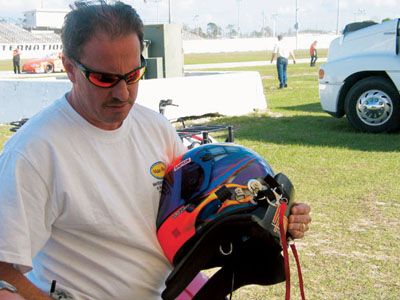
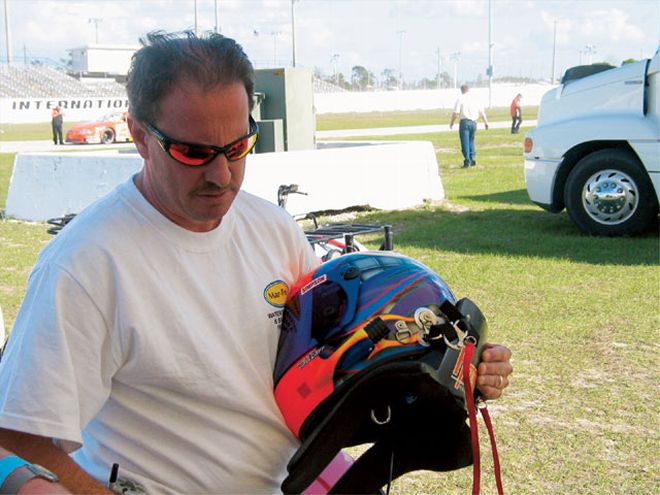 ASA driver Brett Oakley inspects his helmet and HANS(r) before the start of the '04 season opener.
ASA driver Brett Oakley inspects his helmet and HANS(r) before the start of the '04 season opener.
Safety equipment has always faced a longer road to acceptance than parts that can make the car perform better. The death or injury of high-profile drivers may lead to a burst in safety equipment purchases, but it wanes in time. The effort to mandate certain equipment by more sanctions has forced the hand of the racer. The grumbling is being quieted in many pit areas.
While the Head and Neck Support (HANS) system has been in existence for nearly 15 years, it was incorrectly viewed as unnecessary in many racing circles. In 1997, with the help of Daimler Chrysler, the company developed a smaller version, less cumbersome to racers.
As the sport became more safety conscious, the HANS(r) device was soon cast into the spotlight. As one of the forms of head restraint devices approved by sanctioning bodies, drivers soon found themselves looking into the option. Suddenly, saving your neck became an important priority.
How it Works The concept behind the HANS(r) system was developed by Dr. Robert Hubbard and racer Jim Downing. It operates under the physically proven idea that, in racing impacts, the head was subjected to rotation and the neck was stretched. While the torso may have been sufficiently restrained by the belts, the head and neck were victims of the physical forces reverberating through the body. By the use of a tethering system, the head and neck are prevented from extreme movement.
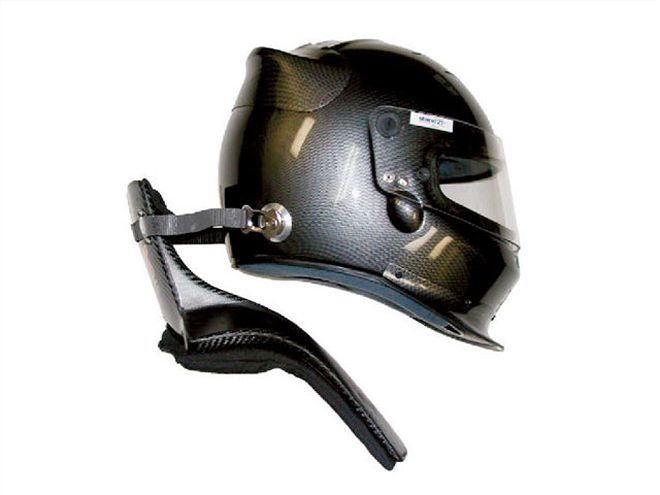 The HANS(r) device simply rests on the driver's shoulders and attaches to the helmet to reduce neck stretch and swivel.
The HANS(r) device simply rests on the driver's shoulders and attaches to the helmet to reduce neck stretch and swivel.
The Proper Device There are currently 10 models in the array of HANS(r) devices. It is not a one-size-fits-all scenario because racers are not all the same size. The most important consideration is the type of racing being done-specifically, the angle of the seat from vertical. In most cases, stock cars will use the 20 Series. This indicates that the seats are approximately 20 degrees from vertical. This is the most upright model with 30 and 40 Series devices used by many open-cockpit racers.
In addition to the angle of the seatback, the physical size of the driver comes into play. The driver's weight and dress-shirt neck collar size are important considerations. There are small (neck size of less than 15 inches), regular (neck size of 15 to 1811/42 inches), and large (neck size greater than 1811/42 inches) styles. Children's models are also available.
There are two styles: professional and economy. The professional model is the lighter choice, made completely of carbon fiber. The economy model has some fiberglass material in the composite. Both are designed to accomplish the same purpose.
Safety-Tested The HANS(r) device was thoroughly tested before introduction to the market in 1990. It has since gone through a battery of tests to determine worthiness in various applications.
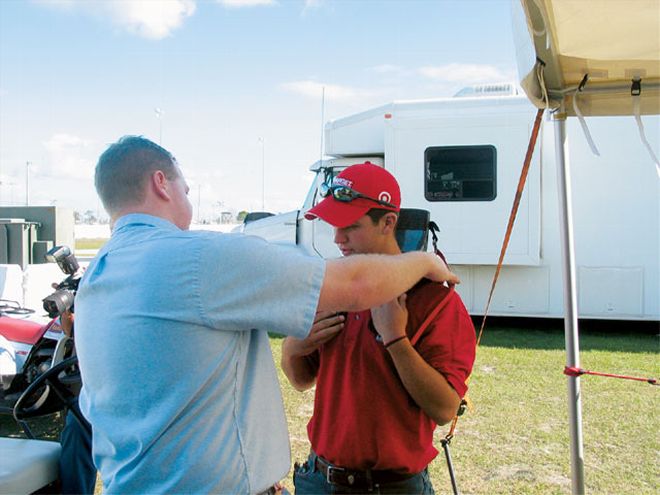 ASA driver Reed Sorenson is getting attention from Ken Adams, HANS(r) director of customer service. Sorenson also replaced the tether straps on his current HANS(r) device.
ASA driver Reed Sorenson is getting attention from Ken Adams, HANS(r) director of customer service. Sorenson also replaced the tether straps on his current HANS(r) device.
The main purpose of the HANS(r) is to keep the head from swinging. This reduces the stretching of the neck. The neck stretch was a critical component in basilar skull fractures, which killed many racers. Additionally, the device reduces the rotation of the head. While the head moves forward in a straight line, brain movement goes along the same plane. Movement from rotation leads to potential brain injury. Through testing, it has been found that loads and acceleration on the driver are best reduced by coupling the body as well as possible with the chassis.
How To Wear It The HANS(r) device slips over the shoulders. The car's shoulder harnesses serve to secure the device to the body. Beneath the collar, there are Nomex-covered medium density foam pads for driver comfort. These pads can also be medical gel. They spread the contact load across the shoulders in the event of an accident.
The lateral edges of the yoke should not interfere with the free movement of the arms and shoulders, such as crossing your arms during steering.
The helmet is attached to the HANS(r) device by use of a post-style or J-clip. Any Snell-rated helmet can be adapted to provide the adequate support for use of the HANS(r) device.
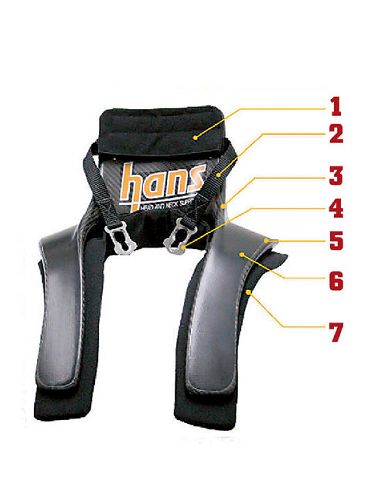
Elements of a HANS(r) Device:
1. Collar pad (attached with Velcro(r))2. Standard tether; also available in quick-disconnect (Q-D) model
3. Collar4. Post-style helmet attachment; J-Clip style also available
5. Yoke6. Rubber laminated to top of yoke
7. Yoke pad (attached with Velcro(r))
Tethers are used from the back of the HANS(r) collar to the helmet. These tethers are replaceable straps. They can be replaced by the end user. Simply remove the strap by taking off two Allen screws and the mounting plate. The strap is threaded through two slots on each side of the back of the device. Tethers can be adjusted for the driver. The tethers are offered in standard or quick-disconnect models.
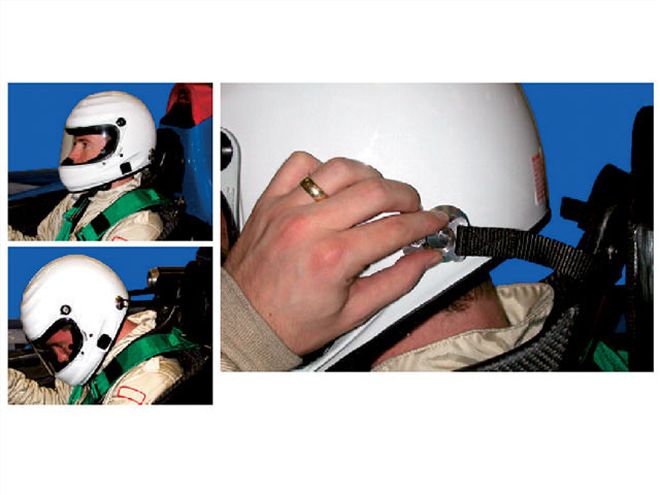 In this series of pictures, the helmet is attached to the HANS(r) yoke. While there is still forward straight line movement, the rotation is reduced. The helmet is attached with no reduction in visibility. The attached tethers provide mobility.
In this series of pictures, the helmet is attached to the HANS(r) yoke. While there is still forward straight line movement, the rotation is reduced. The helmet is attached with no reduction in visibility. The attached tethers provide mobility.
Care of the HANS(r) With proper care, the HANS(r) can last throughout a racer's career. However, there are occasions when you should consider replacement.
If you have been involved in a hard impact, it is best to consider buying a new device (a consideration you should also give to the helmet). If it is minor, there is a good chance that the HANS(r) has withstood it well. If you are unsure, it can be tested. Do not rely on surface inspection as small cracks may not be obvious and the small cracks can compromise the integrity of the device.
Is It Worth It? The HANS(r) device is not the most inexpensive device on the market, but tests have shown it works. It will cost less than a trip to the emergency room at the hospital, so it becomes more of an investment than an expense. Countless drivers have attributed a better result to the device.
These are the results of the crash sled test with an acceleration of 45 g's. The arrows indicate the magnitude of forces from the neck outward.
Ken Adams replaces a tether strap. Adams is using Phillips screws in the replacement. The original unit will have Allen screws. When replacing the tethers, make sure to keep the proper side up and check that the retaining clip is installed properly.